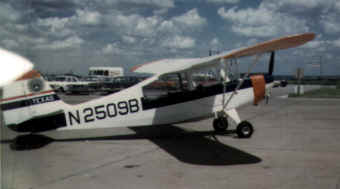A Brief History of the
Early Years of CRUSADER COMPOSITE SQUADRON
Page 2
Lonnie G Walden Builds A Giant CAP Squadron -- Army Style?
When the four of us finally made it out to Navy Dallas in July of '69, we were overwhelmed with all we saw. We learned that CAP was on the TANG side of the base -- the Texas Air National Guard side. Meetings were Tuesdays at 6:30 p.m. There in the middle of the TANG area was a huge, two-story, "H" shaped frame building where CAP had offices. Pulling into the parking lot, we saw Cadets in formation. Inside the building, we found the offices where several adults were busying about with paperwork, boxes, and conversation. Older Cadets were also present. Then we were introduced to Lonnie Gale Walden. He was not very big, prematurely balding, with a cigarette in one hand and a Coke can in the other. I learned later that he was not yet thirty, but to this thirteen-year-old he seemed a larger-than-life middle aged military authority figure.
We got the tour, the briefing, and the membership paperwork. We were told that once we came back with our money and forms, we could go to the supply room and draw 1505s (khakis), fatigues, and summer blues. There might also be boots, belts, shoes, and hats. We watched some drill, sat in the back of an aerospace class, then viewed "closing" -- the closing formation. There we saw promotions, announcements, and heard "details" handed out. We would learn that "details" were a central part of the Walden way. The plan was to come back Saturday morning at 0800. The "work" was done on the weekends. Every weekend.
That Saturday we got our first chance to really look around. The squadron had just recently been given permission to meet here, and Walden set out to show that the Navy had made a smart decision in giving us free use of it. The building had only a few government tenants, and no one had paid much attention to it, or the grounds, or the parking lot. Work consisted of mowing grass, pulling weeds, edging the parking lot with field shovels and picks, cleaning, mopping, and scrubbing. While inside, I noticed Cadets in uniform "bracing" when officers or older Cadets walked through, and there was a lot of "Sir, yes sir!", "By your leave, sir," and "No excuse, sir!" Outside, I saw the gigantic four-engine propeller airplanes taxiing by just a couple hundred feet away. The KC-97s of the 189th TANG Aerial Refueling Wing had a very distinctive engine sound -- not one we hear today. But even more memorable was the piercing, shrill sound the brakes made as they made their way around the hangers and parking area. You always knew when a KC-97 was nearby. The base was also home to F-4s, A-7s, and F-8 Crusaders.
There were a lot of new recruits like myself, but there were also many older Cadets with rank and experience. Senior members, too. We learned that Walden had visited the Arlington squadron, but decided to put together a group of military buddies and start his own squadron. Members from the Arlington squadron, as well as the nearby Irving squadron threw in their support when they heard the news, and suddenly there were dozens of people working to form a team.
Walden, originally from Oklahoma, had served a stint in the Army. His right hand man was Walt Hadeler, an ex-Marine. (I know, once a Marine, always a Marine). Other adults I recall from the very beginning are Sally, Walden's wife at the time; Ellen and Grady Gossett; the Howdershelts; Hilda Hill, Madeline McMurry, John Stanley, Stan Davis, Robert Truitt, and M.A. Billman. Cadets that came to us from either Irving or Arlington included Ernie Davis, Nancy Heath and Arthur Hardin. Older Cadets that were there before me included Cliff Cooksey, Mike Harkness, Mike Fanelli (I think was a Walden relative), Randy Sims, Tom Schneider, Allan Supak, Sue Phipps, Greg Jackson, Glen Sommers, Don Hodge, Laurie and Scott Johnson, Richard Heeth, Kathy Truitt, Sue Hyde, and Robert Herd. I believe Glen Sommers was the first Cadet to reach the Mitchell award who was not a transfer.
Looking at some of the Transportation Authorizations (1969 - 1971) for activities around Texas where Crusader members participated reveals a virtual who's who in CAP at the time. Some would also become familiar in later years: Harold and Bettye Bowden, John Samuel, Luther C. and Clara Bruce Bogard, John Roberts, Joseph L. Cromer, and Ben Davis, Jr.
In the future: Crusader finds a namesake -- a Navy legend
We amass an armada of vehicles - convoy time!
Rebuilding a crashed L-16 -- LTV to the rescue
Building a reputation on Communications -- Eagle Nest 130
And more....
